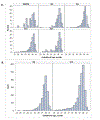Preterm birth phenotypes in women with autoimmune rheumatic diseases: a population-based cohort study
- PMID: 31571337
- PMCID: PMC6908743
- DOI: 10.1111/1471-0528.15970
Preterm birth phenotypes in women with autoimmune rheumatic diseases: a population-based cohort study
Abstract
Objective: To investigate preterm birth (PTB) phenotypes in women with different autoimmune rheumatic diseases in a large population-based cohort.
Design: Retrospective cohort study.
Setting: California, USA.
Population: All live singleton births in California between 2007 and 2011 were analysed. Patients with autoimmune disease at delivery were identified by International Classification of Diseases, Ninth Revision , Clinical Modification (ICD-9-CM), codes for systemic lupus erythematosus (SLE), systemic sclerosis (SSc), rheumatoid arthritis (RA), polymyositis/dermatomyositis (DM/PM), and juvenile idiopathic arthritis (JIA).
Methods: Maternally linked hospital and birth certificate records of 2 481 516 deliveries were assessed (SLE n = 2272, RA n = 1501, SSc n = 88, JIA n = 187, DM/PM n = 38). Multivariable Poisson regression models estimated the risk ratios (RRs) for different PTB phenotypes (relative to term deliveries) for each autoimmune disease compared with the general obstetric population, adjusting for maternal age, race/ethnicity, body mass index, smoking, education, payer, parity, and prenatal care.
Main outcome measures: Preterm birth (PTB) was assessed overall (20-36 weeks of gestation) and by subphenotype: preterm prelabour rupture of membranes (PPROM), spontaneous birth, or medically indicated PTB. The risk of PTB overall and for each phenotype was partitioned by gestational age: early (20-31 weeks of gestation) and late (32-36 weeks of gestation).
Results: Risks for PTB were elevated for each autoimmune disease evaluated: SLE (RR 3.27, 95% CI 3.01-3.56), RA (RR 2.04, 95% CI 1.79-2.33), SSc (RR 3.74, 95% CI 2.51-5.58), JIA (RR 2.23, 95% CI 1.54-3.23), and DM/PM (RR 5.26, 95% CI 3.12-8.89). These elevated risks were observed for the majority of PTB phenotypes as well.
Conclusions: Women with systemic autoimmune diseases appear to have an elevated risk of various PTB phenotypes. Therefore, preconception counselling and close monitoring during pregnancy is crucial.
Tweetable abstract: This study found that women with systemic autoimmune diseases have an elevated risk of preterm birth phenotypes.
Keywords: Autoimmune disease; connective tissue disease; eclampsia; pre-eclampsia; preterm birth; preterm prelabour rupture of membranes.
© 2019 Royal College of Obstetricians and Gynaecologists.
Conflict of interest statement
Disclosure of Interests:
The authors report no conflicts of interest. Completed disclosure of interest forms are available to view online as supporting information.
Figures


Similar articles
-
Racial/ethnic disparities in the risk of preterm birth among women with systemic lupus erythematosus or rheumatoid arthritis.Clin Rheumatol. 2023 Sep;42(9):2437-2444. doi: 10.1007/s10067-023-06606-8. Epub 2023 Apr 26. Clin Rheumatol. 2023. PMID: 37099120 Free PMC article.
-
Women's prepregnancy underweight as a risk factor for preterm birth: a retrospective study.BJOG. 2016 Nov;123(12):2001-2007. doi: 10.1111/1471-0528.14027. Epub 2016 May 13. BJOG. 2016. PMID: 27172996 Free PMC article.
-
Maternal characteristics and mid-pregnancy serum biomarkers as risk factors for subtypes of preterm birth.BJOG. 2015 Oct;122(11):1484-93. doi: 10.1111/1471-0528.13495. Epub 2015 Jun 26. BJOG. 2015. PMID: 26111589 Free PMC article.
-
Pregnancy outcome predictors in systemic lupus erythematosus: a systematic review and meta-analysis.Lancet Rheumatol. 2024 Oct;6(10):e667-e683. doi: 10.1016/S2665-9913(24)00160-7. Epub 2024 Aug 14. Lancet Rheumatol. 2024. PMID: 39153486
-
Autoimmune diseases and adverse pregnancy outcomes: an umbrella review.Lancet. 2023 Nov;402 Suppl 1:S84. doi: 10.1016/S0140-6736(23)02128-1. Lancet. 2023. PMID: 37997130
Cited by
-
Pregnancy and Inflammatory Rheumatological Diseases: A Single-Center Retrospective Cohort Study.Cureus. 2023 Oct 18;15(10):e47277. doi: 10.7759/cureus.47277. eCollection 2023 Oct. Cureus. 2023. PMID: 38021813 Free PMC article.
-
Impact of maternal psoriasis on adverse maternal and neonatal outcomes: a systematic review and meta-analysis.BMC Pregnancy Childbirth. 2023 Sep 30;23(1):703. doi: 10.1186/s12884-023-06006-5. BMC Pregnancy Childbirth. 2023. PMID: 37777747 Free PMC article.
-
Pregnancy outcomes in women with idiopathic inflammatory myopathy, before and after diagnosis-a population-based study.Rheumatology (Oxford). 2020 Sep 1;59(9):2572-2580. doi: 10.1093/rheumatology/kez666. Rheumatology (Oxford). 2020. PMID: 31998957 Free PMC article.
-
Maternal leucocyte trajectory across pregnancy associated with offspring's growth.Pediatr Res. 2022 Sep;92(3):862-870. doi: 10.1038/s41390-021-01827-6. Epub 2021 Nov 8. Pediatr Res. 2022. PMID: 34750526
-
Effects of famotidine use during pregnancy: an observational cohort study.J Pharm Health Care Sci. 2024 Nov 8;10(1):70. doi: 10.1186/s40780-024-00393-3. J Pharm Health Care Sci. 2024. PMID: 39516928 Free PMC article.
References
-
- Saigal S, Doyle LW. An overview of mortality and sequelae of preterm birth from infancy to adulthood. Lancet. 2008;371(9608):261–269. - PubMed
-
- Sibai BM. Diagnosis and management of gestational hypertension and preeclampsia. Obstet Gynecol. 2003;102(1):181–192. - PubMed
-
- Lisonkova S, Sabr Y, Mayer C, Young C, Skoll A, Joseph KS. Maternal morbidity associated with early-onset and late-onset preeclampsia. Obstet Gynecol. 2014;124(4):771–781. - PubMed
-
- Kurkinen-Raty M, Koivisto M, Jouppila P. Preterm delivery for maternal or fetal indications: maternal morbidity, neonatal outcome and late sequelae in infants. BJOG. 2000;107(5):648–655. - PubMed
Publication types
MeSH terms
Grants and funding
LinkOut - more resources
Full Text Sources
Medical

